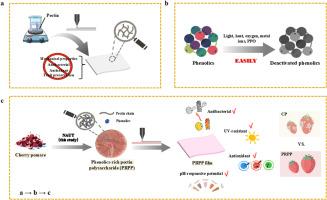樱桃果渣中富含酚类物质的果胶多糖薄膜,用于易腐水果保鲜
IF 11
1区 农林科学
Q1 CHEMISTRY, APPLIED
引用次数: 0
摘要
果胶基薄膜具有良好的食品保鲜前景,但存在机械强度差、脆性高、抗菌活性低等局限性。在果胶薄膜的开发过程中,人们一直在努力解决物理性能变量、抗菌能力和更环保的制造方法之间的权衡。本研究采用温和的非热酸辅助超声介导工艺从樱桃渣中提取富酚果胶多糖(PRPP),制备可食用的果胶保鲜膜。PRPP是一种低甲氧基果胶,富含酚类物质(17.3 mg GAE/g)和阿拉伯糖/半乳糖侧链((Ara + Gal)/Rha: 5.16 mol%)。在成膜过程中,果胶主链和侧链之间发生了分子间/分子内交联,而附着在果胶侧链上的酚类物质为氢键提供了额外的位点,从而增加了果胶分子之间的缠结和交联。所得的PRPP薄膜具有显著提高的机械强度(提高28.5%)、断裂伸长率(提高322%)、水蒸气阻隔性能(提高14.7%),以及优异的紫外线阻隔、抗氧化和抗菌性能。PRPP薄膜能显著延长草莓的货架期,并能在贮藏过程中保持草莓的品质。有趣的是,这种由樱桃果渣果胶制备的PRPP膜在不同ph值下发生了颜色变化,这表明它具有开发ph响应功能膜的潜力。本研究展示了将樱桃渣转化为增值活性保鲜食用薄膜的有效和绿色策略。这种创新方法可以应用于其他富含果胶的水果废弃物的增值利用。本文章由计算机程序翻译,如有差异,请以英文原文为准。

Phenolics-rich pectin polysaccharide film from cherry pomace for perishable fruit preservation
Pectin-based films hold promising prospects for food preservation but have limitations e.g. poor mechanical strength, high brittleness, and low antibacterial activity. There are ongoing efforts to resolve the trade-offs among the physical performance variables, antibacterial capacity, and greener manufacturing approach during the development of pectin films. Herein, a phenolic-rich pectin polysaccharide (PRPP) was extracted from cherry pomace via a mild non-thermal acid-assisted ultrasonic-mediated process to produce an edible film for fruit preservation. PRPP is a low-methoxyl pectin rich in phenolics (17.3 mg GAE/g) and arabinose/galactose side chains ((Ara + Gal)/Rha: 5.16 mol%). During film formation, intermolecular/intramolecular cross-links occurred between the pectin backbone and side chains, while the phenolics attached to pectin's side chains provided additional sites for hydrogen bonding, thereby increasing the entanglements and cross-links among pectin molecules. The resulting PRPP films exhibited significantly enhanced mechanical strength (increased by 28.5 %), elongation at break (increased by 322 %), water vapor barrier property (increased by 14.7 %), along with excellent UV-blocking, antioxidant, and antibacterial properties. The PRPP films could significantly prolong the shelf life of strawberries and greatly maintained fruit quality during storage. Interestingly, this PRPP film prepared from cherry pomace's pectin underwent color changes at different pHs, indicating its potential for the development of pH-responsive functional films. This research demonstrates an effective and greener strategy for converting cherry pomace into value-added active fresh-keeping edible films. This innovative approach can be applied to other pectin-rich fruit wastes for value-added utilization.
求助全文
通过发布文献求助,成功后即可免费获取论文全文。
去求助
来源期刊

Food Hydrocolloids
工程技术-食品科技
CiteScore
19.90
自引率
14.00%
发文量
871
审稿时长
37 days
期刊介绍:
Food Hydrocolloids publishes original and innovative research focused on the characterization, functional properties, and applications of hydrocolloid materials used in food products. These hydrocolloids, defined as polysaccharides and proteins of commercial importance, are added to control aspects such as texture, stability, rheology, and sensory properties. The research's primary emphasis should be on the hydrocolloids themselves, with thorough descriptions of their source, nature, and physicochemical characteristics. Manuscripts are expected to clearly outline specific aims and objectives, include a fundamental discussion of research findings at the molecular level, and address the significance of the results. Studies on hydrocolloids in complex formulations should concentrate on their overall properties and mechanisms of action, while simple formulation development studies may not be considered for publication.
The main areas of interest are:
-Chemical and physicochemical characterisation
Thermal properties including glass transitions and conformational changes-
Rheological properties including viscosity, viscoelastic properties and gelation behaviour-
The influence on organoleptic properties-
Interfacial properties including stabilisation of dispersions, emulsions and foams-
Film forming properties with application to edible films and active packaging-
Encapsulation and controlled release of active compounds-
The influence on health including their role as dietary fibre-
Manipulation of hydrocolloid structure and functionality through chemical, biochemical and physical processes-
New hydrocolloids and hydrocolloid sources of commercial potential.
The Journal also publishes Review articles that provide an overview of the latest developments in topics of specific interest to researchers in this field of activity.
 求助内容:
求助内容: 应助结果提醒方式:
应助结果提醒方式:


